List of Indigenous peoples: Difference between revisions
m Dating maintenance tags: {{Cn}} |
Hemiauchenia (talk | contribs) →African Great Lakes: Massive cull of Africa section, because this includes numerous group that can't really be considered indigenous |
||
| Line 36: | Line 36: | ||
***[[Nsua people|Nsua]]: Western [[Uganda]]{{citation needed|date=August 2020}} |
***[[Nsua people|Nsua]]: Western [[Uganda]]{{citation needed|date=August 2020}} |
||
[[File:Maasai dance.jpg|thumb|A [[Maasai people|Maasai]] traditional dance]] |
[[File:Maasai dance.jpg|thumb|A [[Maasai people|Maasai]] traditional dance]] |
||
*[[Nilo-Saharan languages|Nilo-Saharan]] speakers |
|||
**[[Kalenjin people|Kalenjin]]: [[Kenya]] |
|||
**[[Maasai people|Maasai]]: [[Kenya]], [[Tanzania]] |
|||
**[[Samburu people|Samburu]]: [[Kenya]], [[Tanzania]] |
|||
*[[Bantu languages|Bantu speakers]] |
|||
**[[Abagusii]]: [[Kenya]] |
|||
**[[Kikuyu people|Kikuyu]]: [[Kenya]] |
|||
**[[Luhya people|Luhya]]: [[Kenya]] |
|||
***[[Bukusu]]: [[Kenya]], [[Uganda]] |
|||
*[[Afroasiatic languages|Afroasiatic]] speakers |
|||
**[[Iraqw people|Iraqw]]: [[Tanzania]] |
|||
**[[Rendille people|Rendille]]: [[Kenya]] |
|||
=== Central Africa === |
=== Central Africa === |
||
| Line 73: | Line 61: | ||
***Upemba Twa (Luba Twa): Southeastern [[Democratic Republic of Congo]], [[Upemba Depression]] |
***Upemba Twa (Luba Twa): Southeastern [[Democratic Republic of Congo]], [[Upemba Depression]] |
||
=== Horn of Africa === |
|||
[[File:Somwmnhjbhd3.png|thumb|[[Somalis|Somali]] women in traditional headresses]] |
[[File:Somwmnhjbhd3.png|thumb|[[Somalis|Somali]] women in traditional headresses]] |
||
[[File:Traditional Eritrean dance.jpg|thumb|[[Tigrayans|Tigrayan]] women in traditional attire]] |
[[File:Traditional Eritrean dance.jpg|thumb|[[Tigrayans|Tigrayan]] women in traditional attire]] |
||
[[File:Kawa Tona.jpg|thumb|[[Welayta people|Wolayta]] chief]] |
[[File:Kawa Tona.jpg|thumb|[[Welayta people|Wolayta]] chief]] |
||
[[File:Berta people playing trumpets.jpg|thumb|[[Berta people|Berta]] people playing trumpets during a wedding ceremony]] |
[[File:Berta people playing trumpets.jpg|thumb|[[Berta people|Berta]] people playing trumpets during a wedding ceremony]] |
||
*[[Afroasiatic languages|Afroasiatic]] speakers |
|||
**[[Cushitic languages|Cushitic]] speakers |
|||
***[[Lowland East Cushitic languages|Lowland East Cushitic]] speakers |
|||
****[[Oromo people|Oromo]]: [[Ethiopia]], [[Kenya]] |
|||
****[[Saho-Afar languages|Saho-Afar]] speakers |
|||
*****[[Afar people|Afar]] (Qafár/'Afár): Northeastern [[Ethiopia]], [[Afar Region]] |
|||
*****[[Saho people|Saho]]: Central [[Eritrea]], Southern part of [[Northern Red Sea Region]] |
|||
****[[Somalis]]: [[Somalia]], [[Djibouti]], eastern [[Ethiopia]], northeastern [[Kenya]] |
|||
***[[Highland East Cushitic languages|Highland East Cushitic]] speakers |
|||
****[[Burji people|Burji]]: Southern [[Ethiopia]], [[Southern Nations, Nationalities, and Peoples Region]] (SNNPR) |
|||
*****[[Gedeo people|Gedeo]]: Southern [[Ethiopia]], [[Southern Nations, Nationalities, and Peoples Region]] (SNNPR) |
|||
*****[[Sidama people|Sidama]]: Southern [[Ethiopia]], [[Southern Nations, Nationalities, and Peoples Region]] (SNNPR) |
|||
**[[Semitic languages|Semitic]] speakers |
|||
***[[South Semitic languages|South Semitic]] speakers |
|||
****[[Amhara people|Amhara]] |
|||
****[[Beta Israel]] |
|||
****[[Tigrayans]] |
|||
****[[Tigre people|Tigre]] |
|||
**[[Omotic languages|Omotic]] speakers |
|||
***[[North Omotic]] speakers |
|||
****Gonga-Gimojan peoples |
|||
*****Gonga/Kefoid peoples |
|||
******[[Shinasha people|Shinasha]] ([[Shinasha people|Shinasha]]): Northwestern [[Ethiopia]], |
|||
*****[[Gimojan languages|Gimojan]] peoples |
|||
******[[Yem people|Yem]]: Southwestern [[Ethiopia]], [[Southern Nations, Nationalities, and Peoples Region]] (SNNPR) |
|||
******[[Ometo-Gimira]] peoples |
|||
*******[[Basketo people|Basketo]]: Southwestern [[Ethiopia]], [[Southern Nations, Nationalities, and Peoples Region]] (SNNPR) |
|||
*******[[Maale people|Maale]]: Southwestern [[Ethiopia]], [[Southern Nations, Nationalities, and Peoples Region]] (SNNPR) |
|||
*******[[Welayta people|Wolayta]]: Southwestern [[Ethiopia]], [[Southern Nations, Nationalities, and Peoples Region]] (SNNPR) |
|||
***[[South Omotic]] speakers |
|||
****[[Hamar people|Hamer]]: Southwestern [[Ethiopia]], [[Southern Nations, Nationalities, and Peoples Region]] (SNNPR) |
|||
****[[Banna people|Banna]]: Southwestern [[Ethiopia]], [[Southern Nations, Nationalities, and Peoples Region]] (SNNPR) |
|||
****[[Karo people (Ethiopia)|Karo]]: Southwestern [[Ethiopia]], [[Southern Nations, Nationalities, and Peoples Region]] (SNNPR) |
|||
*[[Nilo-Saharan languages|Nilo-Saharan]] speakers |
|||
**[[Berta people|Berta]]: Western [[Ethiopia]], [[Benishangul-Gumuz Region]], Far Eastern [[Sudan]] |
|||
**[[Eastern Sudanic]] speakers |
|||
***[[Northern Eastern Sudanic languages|Northern Eastern Sudanic]] ([[Astaboran languages|Astaboran]]) speakers |
|||
****[[Nara people|Nara]]: Western [[Eritrea]], [[Gash-Barka Region]], Far Eastern [[Sudan]] |
|||
**[[Gumuz people|Gumuz]]: Western [[Ethiopia]], [[Benishangul-Gumuz Region]], Far Eastern [[Sudan]] |
|||
**[[Kunama people|Kunama]]: Western [[Eritrea]], [[Gash-Barka Region]], Far Eastern [[Sudan]] |
|||
***[[Surmic languages|Surmic]] speakers |
|||
****[[Surma people|Surma]] |
|||
****[[Mursi people|Mursi]] (Mun): mainly in [[Debub Omo Zone]], [[Southern Nations, Nationalities and Peoples Region]], Southwest [[Ethiopia]]. |
|||
=== North Africa === |
=== North Africa === |
||
| Line 188: | Line 132: | ||
[[File:Singing-for-Mokhibo-Lesotho.jpg|thumb|Sotho women wearing the traditional ''Seana Marena'' blanket|269x269px]] |
[[File:Singing-for-Mokhibo-Lesotho.jpg|thumb|Sotho women wearing the traditional ''Seana Marena'' blanket|269x269px]] |
||
[[File:Mozambique001.jpg|thumb|Makua mother and child|alt=|213px]]{{Unreferenced section|date=December 2021}} |
[[File:Mozambique001.jpg|thumb|Makua mother and child|alt=|213px]]{{Unreferenced section|date=December 2021}} |
||
*[[Bantu languages]] speaking peoples of [[Southern Africa]]: [[South Africa]], [[Lesotho]], [[Eswatini]], [[Botswana]], [[Mozambique]], [[Zimbabwe]], [[Namibia]], southern [[Angola]]. |
|||
**[[Nguni people]] |
|||
***[[Xhosa people|Xhosa]] |
|||
***[[Zulu people|Zulu]] |
|||
***Ndebele |
|||
****[[Northern Ndebele people]] (Zimbabwe) |
|||
****[[Southern Ndebele people]] (South Africa) |
|||
*****[[Southern Ndebele language|South Ndebele]] |
|||
*****[[Sumayela Ndebele language|Sumayela Ndebele]] |
|||
***[[Swazi people|Swati]] |
|||
***[[Phuthi language|Phuthi]] |
|||
***[[Lala language (South Africa)|Lala]] |
|||
***[[Bhaca people|Bhaca]] |
|||
***[[Hlubi people|Hlubi]] |
|||
***[[Nhlangwini language|Nhlangwini]] |
|||
**[[Sotho–Tswana]] people |
|||
***[[Tswana people|Tswana]] |
|||
***[[Bobirwa]] |
|||
***[[Tswapong people|Tswapong]] |
|||
***[[Kgalagadi language|Kgalagadi]] |
|||
***[[Sotho people|Sotho]] |
|||
***[[Pedi people|Northern Sotho]] |
|||
***East Sotho (Pulana, Khutswe and Pai) |
|||
***[[Lozi people|Lozi]] |
|||
**[[Makua people]] |
|||
***[[Makhuwa language|Makhuwa]] |
|||
***[[Koti language|Koti]] |
|||
***[[Sakati language|Sakati]] (Nathembo) |
|||
***[[Lomwe language|Lomwe]] |
|||
***[[Chuwabu language|Chuwabu]] |
|||
***[[Moniga language|Moniga]] |
|||
**[[Tswa–Ronga]] languages people |
|||
***[[Tsonga people|Tsonga]] |
|||
***[[Ronga people|Ronga]] |
|||
***[[Tswa people|Tswa]] |
|||
**[[Venda people]] |
|||
**[[Shona people]] |
|||
**[[Chopi people]] |
|||
***[[Chopi language|Chopi]] |
|||
***[[Guitonga language (Mozambique)|Guitonga]] |
|||
**[[Chewa people]] |
|||
**[[Yeyi people]] |
|||
**[[Kavango – Southwest Bantu languages|Kavango]] languages people |
|||
***[[Ovambo people]] |
|||
***[[Herero people]] |
|||
***[[Himba people]] |
|||
***[[Kavango people]] |
|||
*[[Khoisan languages|Southern Khoikhoi languages]] speaking peoples: Angola, Namibia, Botswana, [[Kalahari desert]], Zimbabwe, west and southwestern South Africa. |
*[[Khoisan languages|Southern Khoikhoi languages]] speaking peoples: Angola, Namibia, Botswana, [[Kalahari desert]], Zimbabwe, west and southwestern South Africa. |
||
**[[Khoikhoi]] |
**[[Khoikhoi]] |
||
| Line 256: | Line 155: | ||
**Taa |
**Taa |
||
***ǃXooŋake/Nǀumde |
***ǃXooŋake/Nǀumde |
||
=== West Africa === |
|||
{{Unreferenced section|date=December 2021}} |
|||
*[[Niger-Congo languages|Niger-Congo]] speakers |
|||
**[[Dogon people|Dogon]]: Far Southeastern [[Mali]] and Far Northwestern [[Burkina Faso]] |
|||
**[[Senegambian languages|Senegambian]] speakers |
|||
***[[Fula-Serer languages|Fula-Serer]] speakers |
|||
****[[Serer people|Serer]] ([[Serer people|Sérère]]): [[Senegal]], the [[Gambia]], [[Mauritania]], [[Western Sahara]] |
|||
**[[Benue-Congo]] peoples |
|||
***[[Cross River languages|Cross River]] peoples |
|||
****[[Ogoni people|Ogoni]]: [[Nigeria]] |
|||
**[[Ijoid languages|Ijo]] peoples |
|||
***[[Ijaw people|Ijaw]]/[[Ijo people|Ijo]] people: in the [[Niger delta]] region, southern [[Nigeria]]. |
|||
****[[Itsekiri]] people: in the Niger delta region |
|||
**The Edo speaking people in the old Benin Empire |
|||
**[[Kwa languages|Kwa]] peoples |
|||
***[[Potou-Tano languages|Potou-Tano]] peoples |
|||
****[[Ashanti people|Ashanti]]: [[Ghana]] |
|||
**[[Volta-Niger languages|Volta-Niger]] peoples |
|||
***[[YEAI]] |
|||
****[[Igbo people|Igbo]] ([[Ṇ́dị́ Ìgbò]]): [[Nigeria]] |
|||
****[[Yoruba people|Yoruba]] ([[Yoruba people|Àwọn Ọmọ Yorùbá]]): [[Nigeria]] |
|||
**[[Chadic languages|Chadic]] speakers |
|||
***[[Hausa people|Hausa]]: [[Nigeria]], [[Chad]], [[Sudan]] |
|||
*[[Nilo-Saharan languages|Nilo-Saharan]] speakers |
|||
**[[Fur people|Fur]] ([[Fur people|Fòòrà]]): [[Darfur]], Western [[Sudan]] |
|||
== Eurasia == |
== Eurasia == |
||
Revision as of 19:28, 29 December 2021
This article has multiple issues. Please help improve it or discuss these issues on the talk page. (Learn how and when to remove these template messages)
|
Indigenous people are "those ethnic groups that were indigenous to a territory prior to being incorporated into a national state, and who are politically and culturally separate from the majority ethnic identity of the state that they are a part of".[1] There are internationally recognized definitions of indigenous peoples, such as those of the United Nations, the International Labour Organization and the World Bank.[2][3][4]
This is a partial list of the world's indigenous or aboriginal or native people, grouped by region and sub-region. Note that a particular group may warrant listing under more than one region, either because the group is distributed in more than one region (for example Inuit in North America and eastern Russia), or there may be some overlap of the regions themselves (i.e. the boundaries of each region are not clear, or some locations may commonly be associated with more than one region).
Definition
Indigenous communities, peoples and nations are those which, having a historical continuity with pre-invasion and pre-colonial societies that developed on their territories, and may consider themselves distinct from other sectors of the societies now prevailing on those territories, or parts of them. They form at present non-dominant sectors of society and are determined to preserve, develop and transmit to future generations their ancestral territories, and their ethnic identity, as the basis of their continued existence as peoples, in accordance with their own cultural patterns, social institutions and legal system.[5]
This historical continuity may consist of the continuation, for an extended period reaching into the present of one or more of the following factors:
- Occupation of ancestral lands, or at least of part of them
- Common ancestry with the original occupants of these lands
- Culture in general, or in specific manifestations (such as religion, living under a tribal system, membership of an indigenous community, dress, means of livelihood, lifestyle, etc.)
- Language (whether used as the only language, as mother-tongue, as the habitual means of communication at home or in the family, or as the main, preferred, habitual, general or normal language)
- Residence in certain parts of the country, or in certain regions of the world
- Other relevant factors.
- On an individual basis, an indigenous person is one who belongs to these indigenous populations through self-identification as indigenous (group consciousness) and is recognized and accepted by these populations as one of its members (acceptance by the group). This preserves for these communities the sovereign right and power to decide who belongs to them, without external interference.[6]
Africa
African Great Lakes
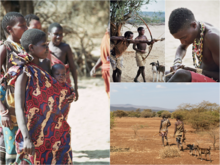
- Hadza (Hadzabe): Tanzania, Singida region: southeast, south and northwest of Lake Eyashi.[citation needed]
- Sandawe: Tanzania, Dodoma region: Kondoa district, between Bubu and Mponde rivers, Singida region.[citation needed]
- Pygmy peoples:
- Twa[citation needed]
- Bangweulu Twa: Northern Zambia, Bangweulu Swamps,[citation needed]
- Great Lakes Twa: Rwanda, Burundi, Uganda, Democratic Republic of Congo[citation needed]
- Kafwe Twa: Southern Zambia, Kafue Flats[citation needed]
- Lukanga Twa: Central Zambia, Lukanga Swamp[citation needed]
- Nsua: Western Uganda[citation needed]
- Twa[citation needed]

Central Africa


- Pygmy peoples:
- Bedzan: Northern Central Cameroon
- Mbenga:
- Aka (Bayaka)
- Baka (Bebayaka): Cameroon, Congo (Brazzaville), Gabon, and Central African Republic
- Bongo (Babongo):
- Gyele (Bagyele):
- Kola (Bakola):
- Mbuti (Bambuti):
- Twa
- Angola Twa: Northeastern, Eastern and Southern Angola
- Kasai Twa (Kuba Twa): Central Democratic Republic of Congo
- Mbote Twa: Southeastern Democratic Republic of Congo, Northwest of Lake Tanganyika
- Mongo Twa (Ntomba Twa): Western Democratic Republic of Congo, Lake Tumba, Lake Mai-Ndombe
- Upemba Twa (Luba Twa): Southeastern Democratic Republic of Congo, Upemba Depression




North Africa


- Afroasiatic languages
- Berbers (Imazighen): Morocco, Tunisia, Algeria, Libya, Egypt, Mauritania, Mediterranean Coast, Atlas Mountains (Idurar n Waṭlas), North and Western Sahara
- Eastern Berbers
- Nafusa: Nafusa Mountains (Drar n infusen), Tripolitania, northwestern Libya
- Zuwara: Zuwara, coast of western Tripolitania in northwestern Libya.
- Matmata: Matmâta, southern Tunisia
- Djerba Berbers: Djerba Island, southern Tunisia coast
- Sokna Berbers: Sokna Oasis (Isuknan), Fezzan, north central Libya, Sahara
- Awjila: Awjila oasis, Cyrenaica, eastern Libya, Sahara
- Ghadamès: Ghadamès Oasis, Western Libya, Sahara
- Northern Berbers
- Kabyles (Iqvayliyen): Kabylie (Tamurt n Iqvayliyen), Mediterranean coast of northern Algeria
- Zenati (Iznaten/Iznasen) speakers: regions in Algeria and Morocco
- Mozabites (At Mzab): Mzab region, northern Sahara, north central Algeria
- Shawiya (Išawiyen): Aurès Mountains (Idurar n Awras), northeastern Algeria
- Shenwa (Ichenwiyen): west-central mountains of northwestern Algeria
- Riffians (Irifiyen): Rif, Rif Mountains (Arrif), northern Morocco
- Sanhaja (Iẓnagen/Iẓnajen) peoples: regions in Middle West Atlas mountains and Eastern Morocco
- Masmuda peoples: regions in Northern and Western Morocco
- Ghomara: Far West Rif Mountains (Arrif), Northern Morocco
- Shilha (Shlḥi): West Atlas mountains, Western Morocco
- Eastern Berbers
- Berbers (Imazighen): Morocco, Tunisia, Algeria, Libya, Egypt, Mauritania, Mediterranean Coast, Atlas Mountains (Idurar n Waṭlas), North and Western Sahara
- Haratin: Indigenous population of the Maghreb and Sahara of uncertain origin; members now speak either Berber languages or Arabic; inhabit Morocco, Mauritania, Western Sahara, Algeria.
Nile Valley
- Afroasiatic speakers
- Egyptian speakers
- Copts (Rem en Khēmi/Rem en Kēme): Egypt, the majority of Egypt's population descended from Ancient Egyptians
- Cushitic speakers
- Beja: Northeastern Sudan, between Red Sea coast and almost to the Nile River (White Nile and Blue Nile) eastern banks, Far Northwest Eritrea, Sahara Eastern Desert, Far Southeast Egypt
- Berber speakers
- Siwi Berbers: Siwa Oasis (Isiwan), western Egypt, Sahara
- Egyptian speakers
- Niger-Congo speakers
- Nuba peoples: Sudan, Nuba Hills
- Katla-Rashad peoples: Sudan, Nuba Hills
- Talodi-Heiban peoples: Sudan, Nuba Hills
- Nuba peoples: Sudan, Nuba Hills

- Serer - current habit Senega, Gambia, Mauritania
- Nilo-Saharan speakers
- Eastern Sudanic speakers
- Northern Eastern Sudanic (Astaboran) peoples
- Nubian speakers
- Nubians: Far Northern North Sudan and Far Southern Egypt, along middle Nile river valley banks
- Nubian speakers
- Southern Eastern Sudanic (Kir-Abbaian) peoples
- Nilotic peoples
- Dinka-Nuer peoples
- Dinka (Jieng): mainly in Lakes, Warrap and Unity States, Upper Nile river course, Central and North South Sudan.
- Nuer (Naadh): mainly in Jonglei State, East of Upper Nile river course, East Central South Sudan.
- Luo peoples
- Anuak (Anywaa): mainly East Jonglei State, East South Sudan, and also mainly in Gambela Region, Lowlands of Far Southwest Ethiopia (border areas between South Sudan and Ethiopia).
- Shilluk (Chollo/Cøllø): mainly in North South Sudan, west of the Upper Nile river course, Upper Nile State, South Sudan (Kodok or Kothok, formerly known as Fashoda is in their territory).
- Dinka-Nuer peoples
- Nilotic peoples
- Northern Eastern Sudanic (Astaboran) peoples
- Fur speakers
- Maban speakers
- Kadu peoples: Sudan, Nuba Hills
- Saharan speakers
- Eastern Sudanic speakers
Southern Africa



- Southern Khoikhoi languages speaking peoples: Angola, Namibia, Botswana, Kalahari desert, Zimbabwe, west and southwestern South Africa.

- Haiǁom
- Gǀu and Gǁana
- Naro
- Tsoa/Tshwa/Kua
- Southern San languages speaking peoples: Angola, Namibia, Botswana, Kalahari desert, west and southwestern South Africa.
- Kx'a/Ju–ǂHoan
- ǃKung/Juu
- ǂʼAmkoe
- ǂKxʼao-ǁʼae (Auen)
- ǃKung/Juu
- Tuu
- ǃKwi (!Ui)
- ǀXam
- ǂKhomani (Nǀu)
- Khwe (Khoi, Kxoe)
- Taa
- ǃXooŋake/Nǀumde
- Kx'a/Ju–ǂHoan
Eurasia
Asia
Middle East/West Asia




- Afroasiatic languages
- Semitic peoples
- East Semitic peoples
- Assyrians (Āṯūrāyē/Sūrāyē/Sūryāyē): A Christian Neo-Aramaic speaking people indigenous to northern Iraq (which was once part of Assyria, Asuristan), southeastern Turkey and northwest of Iran in Upper Mesopotamia, but have also traditionally lived in northeast Syria, albeit recently. There is a testified historical continuity between old Assyrians and modern Assyrians for the majority of people in the same land that they lived since Antiquity before Arabization of Iraq: Northern Mesopotamia that corresponds with old Assyria (originally they were speakers of the Akkadian language but in Antiquity, by the end of the 1st millennium BC, Assyrians adopted the Aramaic language from the Aramaeans and at present time they speak Assyrian Neo-Aramaic). However, not all modern Assyrians identify as such, and several are from peoples that adopted an Assyrian ethnic identity (see Terms for Syriac Christians).[7]
- West Semitic peoples
- Central Semitic peoples
- East Semitic peoples
- Semitic peoples
- Bedouin (Badawī) of the interior deserts of Arabia and Syria.[citation needed]
- Druze (Al-Muwaḥḥidūn/Al-Muwaḥḥidīn/Ahl al-Tawḥīd): of Jabal al-Druze, Syria, Lebanon, Jordan and Israel. The faith of the Druze is a blend of Islam's Ismailism, Judaism, Christianity, Neoplatonism, Pythagoreanism, Gnosticism and Greek philosophy.[citation needed] The foundational text of the faith is the Epistles of Wisdom. Even though they have been a minority for their entire history, they have played a significant role in shaping the history of the Levant. Although the faith originally developed out of Ismaili Islam, Druze are usually not considered Muslims. The oldest and most densely-populated Druze communities exist in Mount Lebanon and in the south of Syria around Jabal al-Druze (literally the "Mountain of the Druze").[citation needed]
- Mandaeans[citation needed]
- Marsh Dwellers/Marsh Arabs (Ma'dan/ʻArab al-Ahwār): An Arabic-speaking people living in the marshes of southern Iraq or on the Iranian side of the Shatt al-Arab.[8]
- Northwest Semitic peoples
- Arameans (Āramayē): Central and Western Syria, ancient land of the Aramaeans (Aram) in the Levant, an Aramaic-speaking people that descends from ancient Aramaeans.[citation needed] In recent years, there has been an attempt to revive Western Aramaic among Aramean Christians living in the Israeli village of Jish.[citation needed]
- Canaanite peoples[citation needed]
- Jews: [9] along with Samaritans, belong to the Israelite nation of the southern Levant, who are believed by archaeologists and historians to have branched out of the Canaanite peoples and culture through the development of a distinct monolatrous—and later monotheistic—religion centered on El/Yahweh,[10][11][12] one of the Ancient Canaanite deities. Following the Roman colonial occupation, destruction of Herod's Temple, and failed Jewish revolts, most Jews were either expelled, taken as slaves to Rome, or massacred,[13] although a small number of Jews managed to remain over the centuries despite persecution by the various conquerors of the region, including the Romans, Arabs, Ottomans, and the British. Additionally, a substantial number of Jews returned from diaspora during the 19th and 20th centuries (mainly under the Zionist movement), as well as after the modern State of Israel was established in 1948. This was coupled with the revival of Hebrew, the only Canaanite language still spoken today. DNA studies show that all major diaspora Jewish communities derive the majority of their ancestry from ancient Israelites.[14][15][16][17]
- There are competing claims that Palestinian Arabs and Jews are indigenous to historic Palestine/the Land of Israel.[18][19][20] The argument entered the Israeli–Palestinian conflict in the 1990s, with Palestinians claiming Indigenous status as a pre-existing population displaced by Jewish settlement, and currently constituting a minority in the State of Israel.[21] Israeli Jews have in turn claimed indigeneity based on historic ties to the region and disputed the authenticity of Palestinian claims.[22][23] In 2007, the Negev Bedouin were officially recognised as Indigenous peoples of Israel by the United Nations.[24] This has been criticised both by scholars associated with the Israeli state, who dispute the Bedouin's claim to indigeneity,[25] and those who argue that recognising just one group of Palestinians as indigenous risks undermining others' claims and "fetishising" nomadic cultures.[26]
- Samaritans (Samerim): of Samaria. An ethno-religious group of the Levant, closely related genetically and culturally to the Jewish diaspora and are understood to have branched off from the latter around the time of the Assyrian exile. The Samaritans are adherents of Samaritanism, an Abrahamic religion closely related to Judaism. Their sole norm of religious observance is the Samaritan Pentateuch.[27][28]
- South Semitic speakers
- Eastern South Semitic speakers
- Bathari people: Dhofar, Southern Oman.[citation needed] Descendants from the original people of Dhofar before Arabization.[citation needed]
- Harasis: Jiddat al-Harasis, Central Oman.[citation needed] Descendants from the original people of South Arabia before Arabization.[citation needed]
- Hobyót people: Dhofar, Southern Oman, Far Eastern Yemen.[citation needed] Descendants from the original people of Dhofar before Arabization.[citation needed]
- Mehris: Al Mahrah, Eastern Yemen, Dhofar, Southern Oman.[citation needed] Descendants from the original people of Dhofar before Arabization.[citation needed]
- Shehri people/Jibbali people: Dhofar, Southern Oman.[citation needed] Descendants from the original people of Dhofar before Arabization.[citation needed]
- Soqotri people: Soqotra island and group of islands, southeast of mainland Yemen, Indian Ocean.[citation needed] Descendants from the original natives of South Arabia before Arabization.[citation needed]
- Eastern South Semitic speakers
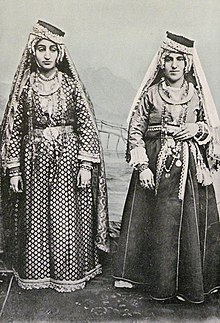
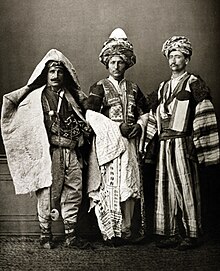


- Indo-European speakers
- Armenians (Hayer): The Christian Armenian people were the original inhabitants of what is now modern Eastern Turkey, specifically around Lake Van and the biblical mountain of Ararat and spoke the Western Armenian language.[citation needed] Since the Armenian genocide in which up to 1,500,000 people perished, the number of the original Armenian inhabitants is almost non-existent and they have since been replaced with ethnic Turks and Kurds.[citation needed]
- Iranian peoples
- East Iranian peoples
- Northeast Iranian peoples
- Ossetians (Iræттæ): South Ossetia, Georgia, Southern Caucasus Mountains[citation needed]
- Northeast Iranian peoples
- West Iranian peoples
- Caspian/South Caspian peoples
- Gilaks: Gilan, North Iran, South Caspian Sea coast and Elburz Mountains[citation needed]
- Mazanderanis/Mazanis/Tabaris: Mazanderan, Tabaristan, Northern Iran, South Caspian Sea coast and Elburz Mountains[citation needed]
- Northwest Iranian peoples
- Northwestern I
- Kurds (Kurd/Kurmandzh): Kurdistan, Northwestern and Western Iran, Northern Iraq, Northeast and Northern Syria, Southeast Turkey, Zagros and East Anatolian Plateau[citation needed]
- Yazidis (Êzidî): Nineveh Governorate, Northern Iraq[citation needed]
- Lak people (Iran): Southwestern Iran, Zagros Mountains[citation needed]
- Zaza-Gorani peoples
- Shabaks: Sinjar District of the Nineveh Governorate in northern Iraq.[citation needed]
- Zazas: Southeastern Turkey, Upper Euphrates river, East Anatolian Plateau[citation needed]
- Kurds (Kurd/Kurmandzh): Kurdistan, Northwestern and Western Iran, Northern Iraq, Northeast and Northern Syria, Southeast Turkey, Zagros and East Anatolian Plateau[citation needed]
- Northwestern II
- Baluchis (Baloch/Baluch): Baluchistan, Southeastern Iran, Southwestern Pakistan, Extreme Southern Afghanistan[citation needed]
- Tatic peoples
- Talysh (Talyshon): Northwestern Iran, Far South Azerbaijan, South Caspian Sea coast and Elburz Mountains[citation needed]
- Tats (Iran)/South Tats (Irünə Tâtün): Northwest Iran[citation needed]
- Northwestern I
- Southwest Iranian peoples
- Larestani–Gulf peoples
- Kumzaris: Northern Musandam, Oman[citation needed]
- Lurs and Bakhtiaris
- Lurs (Lur): Luristan, Western and Southwestern Iran, Zagros Mountains[citation needed]
- Bakhtiaris (Bakhtiar): Southwestern Iran, Zagros[citation needed]
- Tats (Caucasus): Republic of Azerbaijan, Dagestan (Russia)[citation needed]
- Larestani–Gulf peoples
- Caspian/South Caspian peoples
- East Iranian peoples
Caucasus

- Indo-European peoples
- Armenians (Hayer):
- Iranian peoples
- East Iranian peoples
- Northeast Iranian peoples
- Ossetians (Iræттæ): Ossetia (Iryston), North Ossetia (Cægat Iryston), a Republic of Russia, and South Ossetia (Khussar Iryston), a De Jure autonomous region of Georgia (Sakartvelo), self-proclaimed sovereign country, North and South slopes of Central Caucasus Mountains.
- Northeast Iranian peoples
- West Iranian peoples
- Southwest Iranian peoples
- Persian peoples
- Tats (Caucasus) (Tati/Parsi/Lohijon/Daghli): East Caucasus Mountains, Azerbaijan
- Persian peoples
- Southwest Iranian peoples
- East Iranian peoples
- Kartvelian peoples
- Northeast Caucasian peoples
- Avar-Andic peoples
- Dargins (Darganti): Dagestan, European Russia, Northern Caucasus Mountains
- Khinalug (Kettiturdur/Kayttiodur/Ketid/Ketsh Khalkh)
- Lak people (Dagestan): Dagestan, European Russia, Northern Caucasus Mountains
- Lezgic peoples
- Aghul (Agular): Dagestan, European Russia, Northern Caucasus Mountains
- Archins (Arshishttib)
- Budukh (Budad)
- Jeks (Cekad/Dzhekad)
- Kryts (Kh'rytsha'/Kyrtuar)
- Lezgians (Lezgiyar/Leqer): Dagestan, European Russia, Northern Caucasus Mountains
- Rutul (Mykhabyr): Dagestan, European Russia, Northern Caucasus Mountains
- Tabasarans: Dagestan, European Russia, Northern Caucasus Mountains
- Tsakhur (Yiqby): Azerbaijan, Southern Caucasus Mountains
- Udins (Udi/Uti): Northern Azerbaijan, Southern Caucasus Mountains
- Nakh peoples
- Bats (Batsbi)
- Vainakh peoples
- Chechens (Nokhchiy): Chechenia, European Russia, Northern Caucasus Mountains
- Ingush (Ghalghay): Ingushetia, European Russia, Northern Caucasus Mountains
- Tsezic (Didoic) peoples
- Northwest Caucasian peoples
- Abkhaz-Abaza peoples
- Abazins (Abaza)
- Abkhazians (Aphsua): Abkhazia (Aphsny) - a De Jure autonomous region of Georgia (Sakartvelo), self-proclaimed sovereign country.
- Circassian peoples
- West Circassian peoples
- Adyghe (Adyge): Adyghe Republic, European Russia, Northern Caucasus Mountains
- East Circassian peoples
- Cherkess (Cherkes): Karachay-Cherkessia, European Russia, Northern Caucasus Mountains
- Kabardians (Qeberdeykher): Kabardino-Balkaria, European Russia, Northern Caucasus Mountains
- West Circassian peoples
- Ubykh (Tʷaχ): were indigenous to the mountains of West Caucasus, Sochi area, Krasnodar Krai, Russia, later migrated to Turkey.
- Abkhaz-Abaza peoples
Siberia (North Asia)
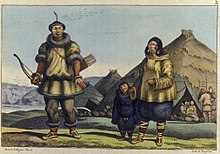


Over 40 distinct peoples, each with their own language and culture in the Asiatic part of Russia (Siberia/North Asia).
- Chukchi-Kamchatkan peoples
- Chukotkan peoples
- Chukchi (Lyg'oravetl'et/Chukchi people|O'ravetl'et/Ankalyn-Chavchu): Northeast Siberia, Russia
- Koryaks (Nymylan-Chauchuven): Russian Far East
- Alyutors: Russian Far East
- Kereks: Russian Far East
- Kamchatkan peoples
- Chukotkan peoples
- Eskimo-Aleut peoples
- Yupik: Alaska and the Russian Far East
- Siberian Yupik (Yupighyt): Siberia, Russia, Alaska, United States.
- Yupik: Alaska and the Russian Far East
- Mongolic peoples
- Buryats (Buryaad): Buryatia, Russia, and Mongolia
- Hamnigans: Zabaykalsky Krai, Russia, Mongolia, and Chine
- Tungusic peoples
- Turkic peoples
- Siberian Turks
- Altaians (Altay-kizhi): titular nation of Altai Republic, Russia
- Chulyms: Tomsk Oblast, Russia
- Dolgans: Northern Siberia
- Khakas (Tadarlar): titular nation of Khakassia, Russia
- Kumandins: Altai Krai, Russia
- Shors: Southern Siberia
- Soyots: Buryatia, Russia
- Teleuts: Kemerovo Oblast, Russia
- Tofalars: Southern Siberia
- Tuvans (Tyvalar): titular nation of Tuva Republic, Russia
- Tozhu Tuvans: Tuva Republic, Russia
- Yakuts (Sakha): titular nation of Yakutia, Russia
- Kipchak Turks
- Siberian Turks
- Ugric peoples
- Ugrians: Yugra, Western Siberia, Russia
- Khanty (Hantõ-Kantõk/Kantek/Khanti): Yugra, Western Siberia, Russia
- Mansi (Maan's'i/Maan's'i Maahum/Mansi), formerly known as Voguls: Yugra, Western Siberia, Russia
- Ugrians: Yugra, Western Siberia, Russia
- Samoyedic peoples
- Northern Samoyedic peoples: West Siberia and Far Northern European Russia
- Enets (Entsi): Far Northern Western Siberia, Russia
- Nenets (Neney Neneche): Far Northern Western Siberia and Far Northern European Russia
- Nganasan (Ŋənəhsa(nəh)): Taymyr Peninsula, Siberia, Russia
- Northern Samoyedic peoples: West Siberia and Far Northern European Russia
- Yukaghirs (Odul/Vadul/Detkil'): Far Northern East Siberia, Russia
- Yeniseian peoples
- Ket (Deng): Along middle Yenisei river banks
- Nivkh (Gilyak): Sakhalin, Russia
- Oroks (Uilta): Sakhalin, Russia
Eurasian Steppe

- Indo-European peoples
- Iranian peoples
- East Iranian peoples
- Northeast Iranian peoples
- Pamiris (Pomir): Badakhshan (Afghanistan, Tajikistan), Pamir Mountains, Tashkurgan (in Xinjiang)
- Tajiks: Tajikistan
- Yaghnobi (Yaγnōbī́t): Tajikistan
- Northeast Iranian peoples
- East Iranian peoples
- Iranian peoples
- Mongolic peoples
- Sino-Tibetan-speaking peoples
- Turkic peoples
- Common Turks
- Karluk Turks (Southeastern Common Turkic peoples)
- Uyghurs (Uyghur): Tarim Basin (Southern Xinjiang), China
- Ili Turks: Ili Kazakh Autonomous Prefecture, Northern Xinjiang, China
- Yugur (Yogïr/Sarïg Yogïr): Sunan Yugur Autonomous County, Gansu province, China
- Salar (Salır): Xunhua Salar Autonomous County, Qinghai province, China
- Dukha (Dukha/Dukhans/Duhalar/Tsaatan): Mongolia
- Uriankhai (Wūliánghǎi/Uriankhan/урианхан/Uriankhat/урианхад): Mongolia
- Kipchak Turks (Northwestern Common Turkic peoples)
- Bashkirs (Başqorttar): Bashkir Republic, European Russia
- Kazakhs: Kazakhstan, China, Mongolia, Russia
- Kyrgyzs: Kyrgyzstan, China
- Krymchaks (Qrymçaklar): Crimean Peninsula in Southern Ukraine
- Crimean Karaites (Qrymqaraylar): Crimean Peninsula in Southern Ukraine
- Crimean Tatars (Qırımtatarlar): Crimean Peninsula in Southern Ukraine
- Volga Tatars (Tatarlar): Tatarstan, European Russia
- Oghuz Turks (Southwestern Common Turkic peoples)
- Karluk Turks (Southeastern Common Turkic peoples)
- Oghur (tribe)
- Chuvash (Chăvаsh): Chuvash Republic, Russia
- Common Turks
South Asia
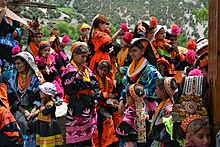



- Adivasis: collective term for many indigenous peoples in India (see also Scheduled Tribes in India)
- Dravidian peoples
- Badaga: Tamil Nadu, South India
- Gond: Gondwana Land, Central India
- Irula: Tamil Nadu, South India
- Kisan: indigenous peoples of the Odisha, East India
- Kodava: Kodagu, Karnataka, South India
- Kota (Kothar/Kov): Tamil Nadu, South India
- Kuruba: Andhra Pradesh, Karnataka, Tamil Nadu, South India
- Tamil: Tamil Nadu, South India and Sri Lanka
- Toda: Tamil Nadu, South India
- South Dravidian peoples
- Indo-European peoples
- Iranian peoples
- Indo-Aryan peoples
- Dard: Dardistan, Khyber-Pakhtunkhwa, Gilgit-Baltistan, Northern Pakistan
- Kalasha of Chitral (Kaĺaśa): Ancient pre-Muslim polytheistic pagan ethnic minority in Chitral District, Northern Pakistan
- Shina: Gilgit-Baltistan, Northern Pakistan
- Kashmiri Hindus: India
- Sindhi: Sindh, Pakistan, India
- Bengali: Bangladesh, India
- Gujarati: India
- Banjara: Rajasthan
- Bhil people: Gujarat, Rajasthan, Madhya Pradesh
- Jaunsari people: Uttarakhand
- Dogras: Jammu
- Tharu: Nepal, East India
- Warli
- Dard: Dardistan, Khyber-Pakhtunkhwa, Gilgit-Baltistan, Northern Pakistan
- Sino-Tibetan-speaking peoples
- Bodish peoples
- Konyak peoples
- Indigenous Assamese people
- Tripuri (Borok): Tripura, North-East India
- Konyak peoples
- Nocte: Tirap, Arunachal Pradesh, North-East India
- Kukish peoples
- Karbi: Karbi Anglong, Assam, North-East-India
- Mizo (Mizo hnam): Mizoram, North-East India
- Naga: Nagaland, North-East India
- Raji-Raute peoples
- Digaro peoples
- Jumma people (a collective term for several peoples)
- Indigenous peoples of Sikkim: India
- Dravidian peoples
- Burusho: Hunza and Chitral districts, Gilgit-Baltistan, Northern Pakistan
- Sino-Tibetan-speaking peoples
- Lolo-Burmese peoples
- Burmish peoples
- Meitei people: Manipur and neighboring states of India, Bangladesh, Myanmur
- Lolo-Burmese peoples
- Vedda (Wanniyala-Aetto): Sri Lanka
- Sinhalese: Sri Lanka
- Dhivehi: Maldives
Southeast Asia

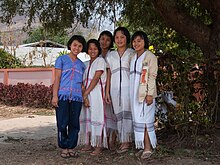
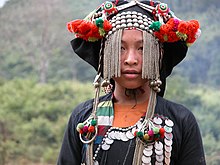
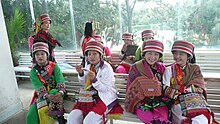

- Austroasiatic peoples
- Aslian peoples
- Senoi (Sengoi/Sng'oi) (a people of the ethnic groups called by the generic word Orang Asli - Original People): in Peninsular Malaysia)[29]
- Khmer Krom: of Vietnam
- Khmuic groups:
- Palaungic peoples
- Wa (Vāx): One of the hill tribes of Myanmar (They are also distributed in Yunnan Province, China in East Asia).
- Zomi (Zo Pau): One of the indigenous people in Southeast Asia. The word Zomi is the collective name given to many tribes who traced their descent from a common ancestor. Through history they have been known under various appellation, such as Chin, Kuki and Mizo, but the expression was disliked by them, and they insist that the term was a misnomer given by others and by which they have been recorded in certain documents designate their ancient origins as a separate ethnicity.
- Vietic peoples
- Aslian peoples
- Austronesian peoples
- Malayo-Polynesian peoples
- Chamic peoples
- Proto-Malay (a people of the ethnic groups called by the generic word Orang Asli - Original People): in Peninsular Malaysia
- Moken: in Myanmar, and Thailand
- Malayo-Polynesian peoples
- Hmong-Mien peoples
- Montagnards (Degar): an umbrella term for several Pre-Vietnamese peoples that dwell in the plateaus and mountains of the southern regions of Vietnam
- Austroasiatic peoples
- Bahnaric peoples
- North Bahnaric peoples
- Central Bahnaric peoples
- Eastern Bahnaric:
- Katuic peoples
- Bahnaric peoples
- Austronesian peoples
- Malayo-Polynesian peoples
- Chamic peoples
- Highlands Chamic peoples
- Rade-Jarai
- Jarai: Central Highlands of Vietnam, as well as in the Northeast Province of Ratanakiri (Cambodia)
- Rhade: Southern Vietnam
- Chru–Northern
- Northern Cham
- Raglai: in Khánh Hòa Province of South Central Coast, and Ninh Thuận Province in the Southeast region of Vietnam
- Northern Cham
- Rade-Jarai
- Highlands Chamic peoples
- Chamic peoples
- Malayo-Polynesian peoples
- Austroasiatic peoples
- Negrito:
- Mani (Maniq): Far Southern Thailand
- Semang (a group of several peoples of the ethnic groups called by the generic word Orang Asli - Original People): Peninsular Malaysia
- Batek: Peninsular Malaysia
- Sino-Tibetan-speaking peoples
- Karenic peoples
- Karen (Per Ploan Poe/Ploan/Pwa Ka Nyaw/Kanyaw): an alliance of hill tribes of Myanmar and Thailand
- Lolo-Burmese peoples
- Akha a.k.a. Aini or Aini-Akha: One of the hill tribes of Thailand, Laos and Burma (They are also distributed in Yunnan Province, China in East Asia).
- Lahu (Ladhulsi/Kawzhawd): One of the hill tribes of Thailand, Myanmar and Laos (They are also distributed in Yunnan, China).
- Lisu: One of the hill tribes of Myanmar and Thailand (They are also distributed in Arunachal Pradesh, India in South Asia and Yunnan and Sichuan, China).
- Rakhine (Rəkhàin lùmjó), Kaman and Marma: Arakan in Myanmar
- Yi (Nuosu/Nisu/Sani/Axi/Lolo): a group of several related peoples mainly in Yunnan, China.
- Tibeto-Burman peoples
- Karenic peoples
- Tai peoples: Vietnam, Myanmar, Laos and Thailand (They are also distributed in Yunnan, China).
- Southwestern Tai peoples


- Austroasiatic peoples
- Nicobarese people (Holchu): Nicobar Islands, India
- Shompen people (Kalay-Keyet): Nicobar Islands, India
- Austronesian peoples
- Malayo-Polynesian peoples
- Barito peoples
- Bajau (Sama/Samah/Samal): Borneo and the Sulu Archipelago (Malaysia, Indonesia, Philippines)
- Dayak: Borneo, (Malaysia and Indonesia)
- Northwest Sumatra–Barrier Islands peoples
- Mentawai peoples
- Malayic peoples
- Orang Laut and Orang Seletar: Malaysia and Singapore
- Proto-Malay (Melayu asli/Melayu purba): Malaysia
- North Bornean peoples
- Philippine peoples
- Igorot (Ifugao: Ipugao; Benguet: Ibaloi, Kankanaey; Mountain Province: Bontoc; Kalinga: Kiangan; Abra: Itneg; Apayao: Isneg):[32] Cordillera mountains in Luzon in the Philippines
- Lumad (Katawhang Lumad): Mindanao in the Philippines
- Mangyan: Mindoro in the Philippines
- Moro: Mindanao and Sulu archipelago in the Philippines
- Tausug (Tausūg/Suluk/Sulug)
- Maguindanao
- Maranao (Iranon/Iranun)
- Tribes of Palawan: Palawan, Philippines
- Barito peoples
- Malayo-Polynesian peoples
- Orang Rimba (Orang Batin Sembilan/Orang Rimba/Anak Dalam/Kubu): Sumatra, Indonesia
- Lubu: Sumatra, Indonesia
- Negrito:
- Andamanese, in the Andaman Islands, which include:
- Great Andamanese: formerly at least 10 distinct groups living throughout Great Andaman, now confined to a single community on Strait Island, Andaman Is.
- Jangil (Rutland Jarawa): now extinct, formerly of Rutland Island, Andamans
- Jarawa: South Andaman and Middle Andaman
- Onge (Önge): Little Andaman, Andaman Islands
- Sentinelese (?): North Sentinel Island, Andaman Islands
- Aeta: Luzon, Philippines
- Ati: Panay, Philippines
- Batak: Palawan, Philippines
- Andamanese, in the Andaman Islands, which include:
- Pribumi (Native Indonesians): of Indonesia
East Asia
Western China
- Turkic peoples
- Äynu peoples
- Ili Turk peoples: Ili Kazakh Autonomous Prefecture
- Uyghur peoples
- Tibetan peoples
North China
- Fuyu Kyrgyz: Fuyu County, Heilongjiang
- Hui peoples
- Tungusic peoples
- Northern Tungusic peoples
- Nanai (Hezhen/Nanai/Hezhe/Golds/Samagir): Heilongjiang in China, Khabarovsk Krai and Primorsky Krai in Russia
- Oroqen: Far Northern China
- Southern Tungusic peoples
- Northern Tungusic peoples
South China


- Hmong-Mien peoples
Taiwan
- Indigenous peoples of the island of Taiwan
Japan
- Ainu (Aynu): Hokkaido, Japan and (until the end of World War II) on Sakhalin Island, Russia
- Japonic peoples
- Ryukyuans (Ruuchuu Minzuku): Old Ryūkyū Kingdom, now Japan
Europe
The question of indigeneity in Europe is a hotly debated topic, with many groups that most would not consider to be indigenous having fringe movements with claims of indigeneity, such as the Shetlanders and Orcadians.[33] The following list only includes groups generally considered to be indigenous.
Europe in general
- The cultures of Old Europe, such as the Minoans, Cucuteni-Trypillia culture, Tartessians, and others were largely wiped out or assimilated during the Kurgan Expansion, and to a lesser extent, expansions by Uralic and Turkic peoples.
- The Romani and subgroups such as the Sinti, although originating as an Indian diasporic group and arriving in Europe by the thirteenth century if not later, have many aspects of indigeneity, such as being largely colonized, carrying unique traditions and culture, among other things. [citation needed]
- Transhumant peoples such as the Greek Sarakatsani, Spanish Cagot, Maragatos, and Pasiegos, and the Balkan Morlachs are often considered indigenous.
Eastern Europe and the European Caucasus


- Finnic peoples
- Baltic Finns
- Izhorians (Ižoralaizet/Inkeroine/Izhora/Izhoralaine/Karjalain/Maaväki): Northwest of Russia
- Karelians (Karjalaižet): Northwest of Russia
- Livonians (Raandalist/Kalamied/Liivõd/Liibõd/Liivnikad/Liivlist): Far Northern Courland Peninsula, Latvia
- Setos (Setokõsõq): Setomaa - Far Southeastern Estonia, southern border region between Estonia and Russia, East Võru County and Northwest Pskov Oblast, southwest of Chudskoye-Pskov/Peipus Lake.
- Veps (Vepslaine/Bepslaane/Lüdinik/Lüdilaine): Republic of Karelia, Northwest of Russia
- Permians
- Komi (Komiyas): Komi Republic in Northeast of European Russia
- Udmurts (Udmurt'yos): Udmurt Republic in Northeast of European Russia
- Sami (Sámi/Saami): Sápmi, Northern and central Norway, Northern Sweden, Northern Finland and Kola peninsula in the Northwest of Russia
- Volga Finns
- Mari: Middle Volga, European Russia
- Mordvins (Erzyat/Mokshet): European Russia
- Erzya people (Erzyat)
- Mokshas (Mokshet)
- Baltic Finns
- Samoyedic peoples
- North Samoyedic peoples
- Nenets (Neney Neneche) : Northeastern part of European Russia
- North Samoyedic peoples
Northern and western Europe
- The Sami are indigenous to Sápmi in northern Norway, Sweden, Finland and the Kola peninsula in Russia. They are legally recognised as indigenous peoples in all four countries.[34][35]
- In the United Kingdom, crofters have asked to be designated as indigenous peoples of the Scottish Highlands. The UK government does not officially recognise any indigenous peoples within the country.[36]
- Irish Travellers have been recognized as indigenous to Ireland since 2017.[37][38]
- The Yenish people in Germany, France, Austria, Switzerland, Belgium, and Luxembourg.[39][40]
- The Indigenous Norwegian Travellers in southern and southwestern Norway.[citation needed]
- Voyageurs in Flanders.[citation needed]
- Indigenous Dutch Travellers in the Netherlands.[citation needed]
- The Indigenous Highland Travellers in the Scottish Highlands[citation needed]
- St Kildans or Hiortaich of St Kilda in Scotland can be considered to be indigenous.[citation needed]
Southern Europe
- Basques: Basque Country and Navarre in Spain, Pyrenees-Atlantiques in France.[citation needed]
- Vaqueiros de alzada in Asturias and northern Castile and León.
- There is a moderate population of Yenish people in Romania.
- Mercheros or Quinqui people in northern Spain.
- The Camminanti of Southern Italy, especially Sicily.
- Dobrujan Tatars in Romania.
- Nogais in Romania.
Americas
Americas is the supercontinent comprising North and South America, and associated islands.
List of peoples by geographical and ethnolinguistic grouping:
North America
North America includes all of the continent and islands east of the Bering Strait and north of the Isthmus of Panama; it includes Greenland, Canada, United States, Mexico, Central American and Caribbean countries. However a distinction can be made between a broader North America and a narrower Northern America and Middle America due to ethnic and cultural characteristics.
- Indigenous peoples in North America by Country
- Indigenous peoples in North America by native cultural regions
Arctic

- Ancient Beringian - Siberia and Alaska
- Eskimo–Aleut
- Aleut (Unangax): Aleutian Islands and Kamchatka Krai
- Eskimo/Yupit-Inuit
- Yupik: Alaska, United States
- Alutiiq (Sugpiat): Alaska, United States
- Central Alaskan Yup'ik (Yupiat/Yupiit): Alaska, United States
- Cup'ik (Cupiit): Alaska, United States
- Cup'ig: Nunivak Island, Alaska, United States
- Siberian Yupik of St. Lawrence Island, Alaska, United States.
- Inuit peoples: Canadian Arctic - Northwest Territories, Nunavik, Nunatsiavut, Nunavut; Greenland; Alaska, United States
- Greenlandic Inuit: Greenland
- Inupiat (Iñupiat): Arctic Alaska, North Slope and boroughs and the Bering Strait
- Inuit people (Inuit): Canadian Arctic
- Eastern Canadian Inuit: East Canadian Arctic, East Nunavut, Nunavik, Nunatsiavut
- Western Canadian Inuit (Inuvialuit): West Canadian Arctic, Inuvialuit Settlement Region, Arctic coast of Northwest Territories, West Nunavut
- Yupik: Alaska, United States
- Métis: a mixed First Nations (from several peoples) and European (from several peoples) people of Canada.
Subarctic
- Na-Dené peoples
- Athabaskan peoples
- Northern Athabaskan peoples
- Dene of Yukon, British Columbia, Manitoba, Northwest Territory, and Alberta, Canada.
- Alaskan Athabaskans
- Southern Alaskan peoples
- Koyukon of Interior Alaska.
- Kutchin of Interior Alaska and the Yukon.
- Tanana Athabaskans.
- Kolchan of Interior Alaska.
- Deg Hit'an of Interior Alaska.
- Dena'ina of Interior Alaska.
- Holikachuk
- Hän of Yukon, Canada, and Alaska, United States.
- Northern Athabaskan peoples
- Athabaskan peoples
- Métis: a mixed Native American (from several peoples) and European (from several peoples) people of Canada.
- Algonquians
- Cree of Montana, United States, and Manitoba, Alberta, and Saskatchewan, Canada.
- Innu of Northeastern Quebec, and Western Labrador, Canada.
- Annishinabe of Quebec, Ontario, and Manitoba, Canada, as well as Kansas, Michigan, Minnesota, Oklahoma, and Wisconsin, United States.
- Beothuk of Newfoundland, Canada.
Pacific Northwest Coast
- Makah of Washington, United States.
- Quinault of Washington, United States.
- Nootka of British Columbia, Canada.
- Kwakiutl of British Columbia, Canada.
- Eyak of Alaska, United States.
- Haida of British Columbia, Canada, and Alaska, United States.
- Tlingit of Alaska, United States.
- Tshimshian of British Columbia, Canada, and Alaska, United States.
Northwest Plateau-Great Basin-California
Northwest Plateau
Great Basin
- Ute of Utah, United States.
- Shoshone of Colorado, Nevada, and Utah, United States.
- Mono of California, United States.
- Bannock of Idaho, United States.
- Western Shoshone of Nevada, United States.
- Timbisha of Nevada, United States.
- Washoe of Nevada, United States.
- Paiute of Colorado, California, Nevada, and Utah, United States.
- Pais of Colorado, Arizona, and New Mexico, United States, as well as Baja California, Mexico.
- Hualapai of Arizona, United States.
- Walapai of Arizona and Colorado, United States.
California
- Yuman-Cochimi peoples
- Cochimí people: Baja California, Mexico
- Core Yuman peoples
- Kiliwa (K'olew): Baja California, Mexico
- Paipai (Akwa'ala/Yakakwal): Baja California, Mexico
- Delta-Californian peoples
- Cocopa (Cocopah/Xawiƚƚ Kwñchawaay): Baja California, Mexico, and Arizona, United States.
- Kumeyaay (Ipai-Tipai/MuttTipi): Baja California, Mexico, and California, United States.
- Miwok of California, United States.
- Maidu of California, United States.
- Wintu of California, United States.
- Chumash of California, United States.
- Tongva of California, United States.
- Modoc of California, and Oregon, United States.
- Athabaskans
- Achumawi of California, and Oregon, United States.
- Hupa of California and Oregon, United States.
- Cahuilla of California, United States.
- Mojave of California, and Nevada, United States.
- Uto-Aztecans
- Mono of California, and Nevada, United States.
- Northern Paiute of California and Nevada, United States.
- Ohlone of California, United States.
- Karok of California, United States.
Great Plains
- Comanche of Texas and Oklahoma, United States.
- Osage of Kansas and Nebraska, United States.
- Sioux of North Dakota, South Dakota, and Minnesota, United States, as well as Saskatchewan, and Alberta, Canada.
- Lakota of South Dakota, United States.
- Dakota people of Minnesota, United States, and Saskatchewan, Canada.
- Kiowa of Texas, and Oklahoma.
- Plains Apache (see the Southwest section for another category this tribe belongs too) of Texas, and Oklahoma.
- Crow of Montana.
- Omaha of Nebraska.
- Blackfoot of Montana, United States, Alberta, Canada, and Saskatchewan, Canada.
Eastern Woodlands
Northeastern Woodlands
- Iroquoian peoples
- Haudenosaunee of New York, Wisconsin, and Oklahoma, United States, as well as Quebec and Ontario, Canada.
- Mohawk of Quebec, Canada, and New York, United States.
- Seneca of New York, and Oklahoma, United States, as well as Ontario, Canada.
- Cayuga of Oklahoma, and New York, United States, as well as Ontario, Canada.
- Oneida of Wisconsin and New York, United States, as well as Ontario, Canada.
- Tuscarora of New York, United States, and Ontario, Canada.
- Onondaga of New York, United States, and Ontario, Canada.
- Wyandot of Kansas, Michigan, and Oklahoma, United States, as well as Ontario, Canada.
- Nation du chat of Upstate New York, Ohio, and Northwest Pennsylvania, United States.
- Susquehannock of Pennsylvania, and West Virginia, United States.
- St. Lawrence Iroquoians: St. Lawrence River, Quebec, Canada, and New York, United States.
- Monongahela: Pennsylvania, West Virginia, and Ohio, United States.
- Nottoway of Virginia, United States.
- Westo of Virginia and South Carolina, United States.
- Haudenosaunee of New York, Wisconsin, and Oklahoma, United States, as well as Quebec and Ontario, Canada.
- Algic peoples
- Algonquian peoples
- Chowanoke of North Carolina.
- Carolina Algonquian
- Powhatan Confederacy of Virginia.
- Wampanoag of Massachusetts.
- Wabanaki of Maine, United States, and New Brunswick and Newfoundland, Canada.
- Abenaki of New Hampshire, Maine and Vermont.
- Penobscot of Maine.
- Miqmac of Maine, New Brunswick, and Newfoundland.
- Passamaquoddy of Maine, United States, and New Brunswick, Canada.
- Maliseet of New Brunswick and Quebec.
- Shawnee of the Ohio River Valley, now Oklahoma.
- Central Algonquian peoples
- Kikapú (Kiikaapoa/Kiikaapoi): indigenous from southeast Michigan, United States, also in Coahuila, Mexico.
- Peoria (Illiniwek)
- Annishinabe
- Ojibwe of Minnesota, North Dakota, and Michigan, United States, as well as Ontario, Canada.
- Potawatomi of Michigan and Indiana, United States, as well as Ontario, Canada.
- Odawa of Oklahoma and Michigan, United States, as well as Ontario, Canada.
- Cree of Alberta, Manitoba, Ontario, Saskatchewan, and the Northwest Territories, Canada, as well as Montana, United States.
- Algonquian peoples
Southeastern Woodlands
- Cherokee of North Carolina, Georgia, and Oklahoma.
- Natchez of Louisiana and Arkansas.
- Muskogeans
- Indigenous peoples of Florida
- Siouans
- Ho-Chunk of Wisconsin and Michigan.
- Catawba of North Carolina.
- Pee Dee of South Carolina.
- Caddoans
- Caddo of Texas, Arkansas, and Louisiana.
- Pawnee of Oklahoma, Nebraska and Kansas, United States.
- Southern Plains villagers of Western Oklahoma, Texas, Kansas, and Southeastern Colorado.
- Arikara of North Dakota, United States.
- Hidatsa of North Dakota, United States.
- Wichita of Oklahoma, Kansas, and Texas, United States.
Southwest
- Uto-Aztecan peoples
- Aztecan (Nahuan) peoples
- Mexicanero (Mēxihcah): Durango, Mexico
- Cáhitan peoples
- Tarahumaran peoples
- Tepiman peoples
- Aztecan (Nahuan) peoples
- Seri (Comcaac): Sonora, Mexico
- Puebloan peoples: Colorado, New Mexico, Arizona, Utah, and Texas, United States
- Hopi of New Mexico, United States.
- Zuni of Arizona, United States.
- Anasazi of New Mexico and Colorado, United States.
- Tiwa of New Mexico, United States.
- Mogollon of New Mexico, Arizona, United States, and Sonora, Mexico.
- Hohokam of Southern Arizona, United States.
- Southern Athabascans
- Apache of Chihuahua, Coahuilla, and Sonora, Mexico, as well as Arizona, New Mexico, Oklahoma, and Texas, United States.
- Chiricahua of Southern New Mexico, Northern Mexico, and Southeast Arizona.
- Lipan Apache of Northern Texas, and Western Oklahoma.
- Plains Apache of Oklahoma.
- Mescalero of Arizona, New Mexico, and Northern Chihuahua.
- Western Apache of Western Arizona.
- Navajo of the Four Corners region.
- Apache of Chihuahua, Coahuilla, and Sonora, Mexico, as well as Arizona, New Mexico, Oklahoma, and Texas, United States.
- O'odham of Sonora, Mexico, and Arizona, United States.
- Pima of Arizona, United States.
- Papago of far Northern Sonora, Mexico, and Southern Arizona, United States.
Mesoamerica


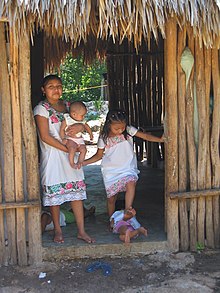


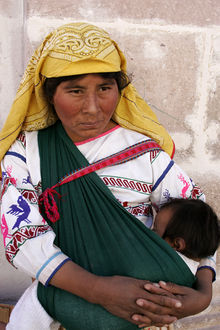
- Huave (Ikoots/Kunajts): Oaxaca, Mexico
- Lenca: Honduras and El Salvador
- Maya peoples
- Ch'olan peoples
- Huastec (Téenek/Te' Inik): San Luis Potosí, Mexico
- Mamean peoples
- Q'anjobalan peoples
- Qichean peoples
- Yucatecan peoples
- Mixe-Zoquean peoples
- Oto-Manguean peoples
- Amuzgo (Tzjon Non/Tzo'tyio/Ñ'anncue): Oaxaca, Mexico
- Chinantec: Oaxaca, Mexico
- Manguean
- Chorotega (Mangue/Mankeme): Honduras, Nicaragua, and Costa Rica
- Mixtecan
- Oto-Pamean peoples
- Chichimeca Jonaz (Úza): San Luis Potosí, Mexico
- Matlatzinca: Mexico (state), Mexico
- Mazahua (Tetjo Ñaa Jñatjo): Mexico (state), Mexico
- Otomi (Hñähñu/Hñähño/Ñuhu/Ñhato/Ñuhmu): Central Mexico, Mexico
- Pame (Xi'úi): San Luis Potosí, Mexico
- Popolocan peoples
- Tlapanec (Me'phaa): Guerrero, Mexico
- Zapotecan peoples
- Tarascan (P'urhépecha): Michoacán, Mexico
- Tequistlatecan/Chontal de Oaxaca: Oaxaca, Mexico
- Totonacan peoples
- Uto-Aztecan peoples
- Xinca (Xinka): Guatemala
Circum-Caribbean


- Chibchan peoples
- Boruca: Costa Rica
- Bribri: Costa Rica
- Cabécar: Costa Rica
- Naso/Teribe/Tjër Di: Costa Rica, Panama
- Guaymi/Waimi peoples
- Bokota: Panama
- Ngäbe–Buglé: Panama, Costa Rica
- Talamanca peoplesl
- Kuna (Dule/Tule): Panama
- Pech: Honduras
- Votic peoples
- Chocó/Embera-Wounaan peoples
- Misumalpan peoples
- Tolupan/Jicaque: Honduras
- Zambo/Cafuso peoples (mixed West African and Amerindian peoples)
- Garífuna: A mixed West African (from several peoples) and Amerindian people (mainly from the Island Caribs - Kalhíphona) that traditionally speaks an Arawakan language in Belize and Honduras.
- Miskito Sambu: A mixed West African (from several peoples) and Amerindian people (mainly from the original Miskito) that traditionally speaks Miskito, a Misumalpan language, and also Nicaragua Creole English in Nicaragua and Honduras.
- Black Seminoles: Florida, The Bahamas, and Mexico. (Mixed Seminole and African).
West Indies

The West Indies, or the Caribbean, generally includes the island chains of the Caribbean Sea.
- Arawakan peoples
- Northern
- Circum-Caribbean/Ta-Arawakan peoples
- Eyeri/Igneri: Lesser Antilles. An Arawak people, may have been the Kalinago/Island Caribs before caribbeanization. (The Island Caribs had the tradition that the Igneri were the older people of Lesser Antilles but they could have been ancestors of the majority of Island Caribs).
- Island Caribs (Carib/Kalinago/Kalhíphona): Lesser Antilles. Often called "Island Caribs" (but may have been an older arawak people with a carib conquering warrior elite or influenced by Mainland Caribs. Apparently, the majority of the people spoke an arawakan language and not a carib one.)
- Taíno: Amerindians who originally inhabited the Greater Antilles of the Caribbean, they are of Arawakan descent.
- Neo-Taíno nations Some scholars distinguish between the Taíno and Neo-Taíno groups. Neo-Taíno groups were also Amerindians of the Antilles islands, but had distinctive languages and cultural practices that differed from the High Taíno.[41] These groups include:
- Ciboney: a term preferred in Cuban historical texts for the neo-Taino-Siboney nations of the island of Cuba.
- Ciguayo: Eastern Hispaniola
- Lucayans: Based in the Bahamas.
- Macorix: Hispaniola.
- Neo-Taíno nations Some scholars distinguish between the Taíno and Neo-Taíno groups. Neo-Taíno groups were also Amerindians of the Antilles islands, but had distinctive languages and cultural practices that differed from the High Taíno.[41] These groups include:
- Circum-Caribbean/Ta-Arawakan peoples
- Northern
- Guanahatabey people: Western Cuba island, a Pre-Arawakan and Pre-Island Carib people of the Caribbean Islands.
South America

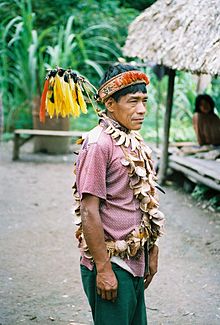
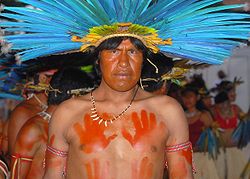

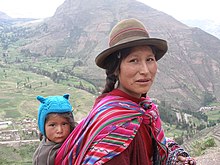
South America generally includes all of the continent and islands south of the Isthmus of Panama.
- Indigenous peoples in South America by Country:
- Indigenous peoples in South America by native cultural regions
Circum-Caribbean (Chibcha)
- Arawakan peoples
- Northern
- Chibchan peoples
- Chocoan peoples
- Warao: Venezuela's Orinoco River delta region.
Amazon
- Arawakan peoples
- Barbacoan peoples
- Awan
- Awá-Kwaiker: Northern Ecuador
- Awan
- Bora-Witoto peoples
- Cahuapanan peoples
- Jivaroan (Shuar): Loreto and San Martín, Peru
- Nukak: Colombia
- Panoan peoples
- Pirahã: Brazil
- Ticuna-Yuri peoples
- Tucanoan peoples
- Tupian peoples
- Urarina (Kachá): Chambira Basin, Loreto Peru
- Yanomami (Yanõmami/Yanõmami Thëpë): Venezuela/Brazil
Guianas
- Cariban peoples
- Yanomami (Yanõmami/Yanõmami Thëpë): Venezuela/Brazil
- Piaroa (Wothïha): Venezuela/Colombia
Eastern Highlands (Brazilian Highlands)
- Charruan peoples
- Macro-Gê peoples
- Tupian peoples
- Tupí-Guaraní
Chaco
Central Andes
- Aymaran peoples
- Nasa: Colombia
- Quechuan peoples
Southern Cone
Araucania
- Araucanian peoples
Patagonia
Tierra del Fuego
- Alacalufe (Kawésqar): Far Southern Chile
- Selk'nam: Southern Argentina and Chile
- Yaghan (Yámana): Far Southern Chile
- Haush: Far Southern Argentina
Oceania
Oceania includes most islands of the Pacific Ocean, New Guinea, New Zealand and the continent of Australia.
List of peoples by geographical and ethnolinguistic grouping:
Australia

Indigenous Australians include Aboriginal Australians on the mainland and Tiwi Islands as well as Torres Strait Islander peoples from the Torres Strait Islands.
- Aboriginal Australians include hundreds of groupings of people, defined by various overlapping characteristics such as language, culture and geography, which may include sub-groups. The Indigenous peoples of the island state of Tasmania and the Tiwi people (of the Tiwi Islands off the Northern Territory) are also Aboriginal peoples, who are genetically and culturally distinct from Torres Strait Islander peoples.
- Torres Strait Islander peoples are culturally and linguistically Papuo-Austronesian, and the various peoples of the islands are of predominantly Melanesian descent. The Torres Strait Islands are part of the state of Queensland
- Brinja People:[42] Bugelli-manji now called the Brinja Aboriginal People[43] from the South Coast of New South Wales. Clinical anthropologist at Bega hospital in 1966 showed three groups of Aboriginal people on the South Coast of New South Wales. The Brinja People were the central Group with the Walbunja People north of the Moruya River with sub-group at Broulee and Batemans Bay. To the South of the Brinja,[44] south of Corunna lake are the Tadera - manji, in the Bega district and Thauaira, east of Malagoota Inlet.[45]
Western Desert
- Pama-Nyungan peoples
- Kunapa: Northern Territory, Australia
- Pini: Western Australia, Australia
- Spinifex: Western Australia, Australia
- Wangkatha: Western Australia, Australia
- Warumungu: Northern Territory, Australia
- Wati peoples
- Antakirinja: South Australia, Australia
- Kokatha: South Australia, Australia
- Luritja: Northern Territory, Australia
- Madoidja: Western Australia, Australia
- Maduwongga: Western Australia, Australia
- Martu peoples
- Marrngu peoples
- Ngaanyatjarra: Northern Territory, Australia
- Ngaatjatjarra: Western Australia, Australia
- Pintupi: Western Australia, Australia
- Pitjantjatjara: Northern Territory, Australia
- Wangkatjunga: Western Australia, Australia
- Yankunytjatjara: South Australia, Australia
- Yulparirra: Western Australia, Australia
- Yumu: Northern Territory, Australia
- Yankuntjatjarra: South Australia, Australia
- Mirindi peoples
Kimberley
- Bunuban peoples
- Jarrakan peoples
- Gija: Halls Creek and Kununurra, Western Australia, Australia
- Miriwoongic peoples
- Miriwoong: Kunurra, Western Australia, Australia
- Gajirrawoong: Eastern Kimberley and Northern Territory, Australia
- Nyulnyulan peoples
- Nyulnyulic peoples
- Dyukun peoples
- Worrorran peoples
Northwest
- Pama-Nyungan peoples
- Ngayarda peoples
- Bailgu: Pilbara region, Western Australia, Australia
- Inawongga: Pilbara region, Western Australia, Australia
- Jadira: Pilbara region, Western Australia, Australia
- Kurrama: Pilbara region, Western Australia, Australia
- Mardudunera: Pilbara region, Western Australia, Australia
- Ngarla: Pilbara region, Western Australia, Australia
- Ngarluma: Pilbara region, Western Australia, Australia
- Niabali: Pilbara region, Western Australia, Australia
- Nhuwala: Pilbara region, Western Australia, Australia
- Nyamal: Pilbara region, Western Australia, Australia
- Panyjima: Pilbara region, Western Australia, Australia
- Tjuroro: Pilbara region, Western Australia, Australia
- Kanyara-Mantharta peoples
- Kanyara peoples
- Baiyungu: Gascoyne region, Western Australia, Australia
- Binigura: Pilbara region, Western Australia, Australia
- Buruna: Mid West region, Western Australia, Australia
- Thalanyji: Pilbara region, Western Australia, Australia
- Yinikutira: Exmouth, Western Australia, Australia
- Mantharta peoples
- Djiwali: Pilbara region, Western Australia, Australia
- Tharrkari: Gascoyne region, Western Australia, Australia
- Tenma: Pilbara region, Western Australia, Australia
- Warriyangga: Gascoyne region, Western Australia, Australia
- Kanyara peoples
- Kartu peoples
- Badimaya: Mid West region, Western Australia, Australia
- Maia: Mid West region, Western Australia, Australia
- Malgana: Mid West region, Western Australia, Australia
- Nanda: Mid West region, Western Australia, Australia
- Nokaan: Mid West region, Western Australia, Australia
- Wajarri: Mid West region, Western Australia, Australia
- Widi: Mid West region, Western Australia, Australia
- Yingkarta: Gascoyne region, Western Australia, Australia
- Ngayarda peoples
Southwest
- Pama-Nyungan peoples
- Nyungic peoples
- Noongar peoples
- Amangu: Geraldton Sandplains, Western Australia, Australia
- Ballardong: Avon Wheatbelt, Western Australia, Australia
- Yued: Swan Coastal Plain, Western Australia, Australia
- Kaneang: Jarrah Forest, Western Australia, Australia
- Koreng: Mallee, Western Australia, Australia
- Mineng: Warren, Western Australia, Australia
- Njakinjaki: Avon Wheatbelt, Western Australia, Australia
- Njunga: Esperance Plains, Western Australia, Australia
- Bibulman: Warren, Western Australia, Australia
- Pindjarup: Jarrah Forest, Western Australia, Australia
- Warandi: Swan Coastal Plain, Western Australia, Australia
- Whadjuk: Jarrah Forest, Western Australia, Australia
- Wiilman: Western Australia, Australia
- Wudjari: Mallee, Western Australia, Australia
- Kalaako: Goldfields–Esperance region, Western Australia, Australia
- Kalamaia: Western Australia, Australia
- Mirning peoples
- Yingkarta: Gascoyne region, Western Australia, Australia
- Noongar peoples
- Nyungic peoples
Fitzmaurice Basin
- Yirram peoples
- Macro-Gunwinyguan peoples
- Kungarakany: Northern Territory, Australia
- Warrayic peoples
- Kungarakany: Northern Territory, Australia
- Daly peoples
- Wagaydic peoples
- Mulluk-Mulluk: Northern Territory, Australia
- Western Daly peoples
- Emmiyangal: Anson Bay, Northern Territory, Australia
- Marranunggu: Daly River, Northern Territory, Australia
- Menthe: Northern Territory, Australia
- Marrithiyal: Daly River, Northern Territory, Australia
- Maramanindji: Northern Territory, Australia
- Marridan: Northern Territory, Australia
- Marri Amu: Northern Territory, Australia
- Marri Tjevin: Northern Territory, Australia
- Marijedi: Northern Territory, Australia
- Marri Ngarr: Moyle River, Northern Territory, Australia
- Mati Ke: Wadeye, Northern Territory, Australia
- Eastern Daly peoples
- Southern Daly peoples
Arnhem Land
- Pama-Nyungan peoples
- Macro-Gunwinyguan peoples
- Maningrida peoples
- East Arnhem peoples
- Marran peoples
- Gaagudju: Northern Territory, Australia
- Gunwinyguan peoples
- Gunwinggic peoples
- Dalabon: Northern Territory, Australia
- Jawoyn: Nitmiluk National Park, Northern Territory, Australia
- Jala peoples
- Iwaidjan peoples
- Amurdak: Cobourg Peninsula, Northern Territory, Australia
- Iwaidjic peoples
- Marrku-Wurrugu peoples
Top End
- Tiwi: Tiwi Islands, Northern Territory, Australia
- Darwin Region peoples
- Larrakia: Darwin, Northern Territory, Australia
- Limilngan
- Umbugarlic peoples
- Giimbiyu: Alligator Rivers, Northern Territory, Australia
Gulf Country
- Pama-Nyungan peoples
- Tankgkic peoples
- Garawan peoples
Cape York
West Cape
- Pama-Nyungan peoples
- Paman peoples
- North Cape York Paman peoples
- Djagaraga: Cape York Peninsula, Queensland, Australia
- Tjungundji: Cape York Peninsula, Queensland, Australia
- Injinoo: Cape York Peninsula, Queensland, Australia
- Luthigh: Cape York Peninsula, Queensland, Australia
- Mbewum: Cape York Peninsula, Queensland, Australia
- Tjungundji: Cape York Peninsula, Queensland, Australia
- Totj: Cape York Peninsula, Queensland, Australia
- Unduyamo: Cape York Peninsula, Queensland, Australia
- Wik peoples
- Wik-Mungkan: Cape York Peninsula, Queensland, Australia
- Kugu Nganhcara: Cape York Peninsula, Queensland, Australia
- Wiknatanja: Cape York Peninsula, Queensland, Australia
- Wik Me'anh: Cape York Peninsula, Queensland, Australia
- Wik Epa: Cape York Peninsula, Queensland, Australia
- Wik Elken: Cape York Peninsula, Queensland, Australia
- Wik Paach: Cape York Peninsula, Queensland, Australia
- Wik Ompom: Cape York Peninsula, Queensland, Australia
- Wimaranga: Cape York Peninsula, Queensland, Australia
- Winduwinda: Cape York Peninsula, Queensland, Australia
- Thaypan peoples
- North Cape York Paman peoples
- Paman peoples
East Cape
- Pama-Nyungan peoples
- Paman peoples
- North Cape York Paman peoples
- Lamalamic peoples
- Northeast Paman peoples
- Paman peoples
Daintree Rainforest
- Pama-Nyungan peoples
Lake Eyre Basin
- Pama-Nyungan peoples
- Kalkatungic peoples
- Karnic peoples
- Yarli peoples
Spencer Gulf
- Pama-Nyungan peoples
- Thura-Yura peoples
- Wirangu: South Australia, Australia
- Nauo: Eyre Peninsula, South Australia, Australia
- Barngarla: Eyre Peninsula, South Australia, Australia
- Kuyani: South Australia, Australia
- Adnyamathanha: Flinders Ranges, South Australia, Australia
- Malyangapa: New South Wales, Australia
- Ngadjuri: South Australia, Australia
- Nukunu: South Australia, Australia
- Narungga: Yorke Peninsula, South Australia, Australia
- Kaurna: Adelaide Plains, South Australia, Australia
- Peramangk: Adelaide Plains, South Australia, Australia
- Thura-Yura peoples
Murray-Darling Basin
- Pama-Nyungan peoples
- Yotayotic peoples
- Lower Murray peoples
- Wiradhuric peoples
- Muruwari: New South Wales and Queensland, Australia
Northeast
- Pama-Nyungan peoples
- Lower Burdekin peoples
- Maric peoples
- Biri peoples
- Gugu-Badhun: Burdekin River, Queensland, Australia
- Yilba: Mackay, Queensland, Australia
- Gia: Queensland, Australia
- Biria: Queensland, Australia
- Yambina: Queensland, Australia
- Garaynbal: Queensland, Australia
- Yangga: Queensland, Australia
- Baranha: Queensland, Australia
- Miyan: Queensland, Australia
- Yuwibara: Queensland, Australia
- Kingkel peoples
- Biri peoples
- Waka-Kabic peoples
Southeast
- Pama-Nyungan peoples
- Yugambeh-Bundjalung peoples
- Gumbaynggiric peoples
- Anēwan: Northern Tablelands, New South Wales, Australia
- Yuin-Kuric peoples
- Djangadi: Macleay Valley, New South Wales, Australia
- Geawegal: Hunter Valley, New South Wales, Australia
- Worimi: New South Wales, Australia
- Wonnarua: New South Wales, Australia
- Awabakal: New South Wales, Australia
- Eora: New South Wales, Australia
- Darug: New South Wales, Australia
- Gandangara: New South Wales, Australia
- Tharawal: Sydney, New South Wales, Australia
- Ngarigo: New South Wales and Victoria, Australia
- Koori: New South Wales and Victoria, Australia
- Gippsland peoples
- Kulinic peoples
Tasmania
- Palawa peoples
- Western Tasmanian peoples
- Northern Tasmanian peoples
- Tommeginne: Northern Tasmania, Australia
- Northeastern Tasmanian peoples
- Pyemmairre: Northeastern Tasmania, Australia
- Tyerrernotepanner: Northern Midlands and Ben Lomond, Tasmania, Australia
- Eastern Tasmanian peoples
- Paredarerme: Oyster Bay, Tasmania, Australia
- Lairmairrener: Big River, Tasmania, Australia
- Nuennone: Bruny Island, Tasmania, Australia
Torres Strait Islands
Melanesia
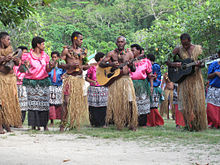
Melanesia generally includes New Guinea and other (far-)western Pacific islands from the Arafura Sea out to Fiji. The region is mostly inhabited by the Melanesian peoples.
- Melanesians
- Austronesian speaking Melanesians
- Fijians (iTaukei): Fiji
- Kanak: New-Caledonia
- Malaitan people: Malaita, Solomon Islands
- Ni-Vanuatu: Vanuatu
- Papuan speaking Melanesians
- Austronesian speaking Melanesians
- Papuans: more than 250 distinct tribes or clans, each with their own language and culture. The main island of New Guinea and surrounding islands (territory forming independent state of Papua New Guinea (PNG) and the Indonesian provinces of West Papua and Papua). Considered "Indigenous" these people are a subject to many debates.
- Sepik peoples
- Kwoma: Peilungua Mountains, Papua New Guinea.
- Iatmul: Sepik, Papua New Guinea.
- Sepik Hill
- Sanio
- Hewa: Southern Highlands, PNG
- Sanio
- Trans New-Guinean peoples
- Huli of the Southern Highlands, Papua New Guinea.
- Angu: Southwestern Morobe Province, Papua New Guinea.
- Bosavi
- Kaluli-Kasua
- Kaluli: Great Papuan Plateau, PNG
- Kaluli-Kasua
- Ok
- Mountain Ok
- Wopkaimin: western PNG, Star Mountains.
- Mountain Ok
- West Trans New-Guinean peoples
- Dani: Papua, Indonesia
- Korowai: West Papua, close to the Papua New Guinea border.
- Asmat: Asmat Regency, West Papua.
- Sepik peoples
Micronesia
Micronesia generally includes the various small island chains of the western and central Pacific. The region is mostly inhabited by the Micronesian peoples.
Polynesia

Polynesia includes New Zealand and the islands of the central and southern Pacific Ocean. The region is mostly inhabited by the Polynesian peoples.
- Polynesians
- Ellicean–Outlier
- Futunic
- Marquesic
- Kanaka Maoli: Hawaii, United States
- Marquesan and Mangarevan
- Rapanui: Easter Island (Rapanui)
- Samoic
- Samoans (Tagata Māoʻi): Samoa, American Samoa
- Tokelau: Tokelau
- Tahitic
- Austral Islanders: Austral Islands
- Cook Islands Māori: Cook Islands
- Maohi: Tahiti
- Māori: New Zealand
- Moriori: Chatham Islands (Rēkohu), New Zealand
- Tahitians (Ta'ata Tahiti (Ma'ohi)) : Tahiti, French Polynesia
- Tuamotu: Tuamotu Archipelago
- Tongic
- Polynesians
- Ellicean–Outlier
- Futunic
- Anuta: Solomon Islands
- Fagauvea: Ouvéa (New Caledonia)
- Futuna and Aniwa: Vanuatu
- Emae: Vanuatu
- Makata: Vanuatu
- Mele (Erakoro, Eratapu): Vanuatu
- Rennel and Bellona: Solomon Islands
- Tikopia: Solomon Islands
- Vaeakau-Taumako: Solomon Islands
Circumpolar
Circumpolar peoples is an umbrella term for the various indigenous peoples of the Arctic.
List of peoples by ethnolinguistic grouping:
- "Paleosiberian"
- Chukotko-Kamchatkan
- Chukchi (Lyg'oravetl'et/O'ravetl'et): Siberia, Russian Far East, Russia
- Koryaks (Nymylan-Chauchuven): Russian Far East
- Tungusic
- Chukotko-Kamchatkan
- Eskimo–Aleut
- Aleut (Unangax): Aleutian Islands and Kamchatka Krai
- Eskimo/Yupik-Inuit
- Yupik: Alaska, United States and the Russian Far East, Siberia
- Alutiiq (Sugpiat): Alaska, United States
- Yup'ik (Yupiat/Yupiit/Cup'ik/Cupiit): Alaska, United States
- Cup'ig (Nunivak Cup'ig people): Nunivak Island (Alaska), United States
- Siberian Yupik (Yupighyt): Siberia, Russia
- Inuit: Greenland, Northern Canada (Nunavut, Nunavik and Northwest Territories), Alaska, United States
- Inupiat (Iñupiat): Alaska's Arctic and North Slope boroughs and the Bering Straits
- Kalaallit (Kalaallit): Greenland
- Yupik: Alaska, United States and the Russian Far East, Siberia
- Turkic
- Northeast Turks
- Dolgans (Dolgan/Tya Kikhi): Siberia (Krasnoyarsk Krai), Russia
- Yakuts (Sakha): Siberia (Sakha Republic), Russia
- Northeast Turks
- Ugrians, Yugra, Siberia, Russia
- Sami (Sámi/Saami/Lapp), formerly known by the exonym Lapps: Northern Norway, Sweden, Finland, and Kola Peninsula in Russia
- Samoyedic peoples
- Northern Samoyedic peoples: West Siberia and Far Northern European Russia
- Enets (Entsi): Far Northern Western Siberia, Russia
- Nenets (Neney Neneche): Far Northern Western Siberia and Far Northern European Russia
- Nganasan (Ŋənəhsa(nəh)): Taymyr Peninsula, Siberia, Russia
- Northern Samoyedic peoples: West Siberia and Far Northern European Russia
- Yukaghirs (Odul/Vadul/Detkil'): Far Northern East Siberia, Russia
See also
- Center for World Indigenous Studies
- Declaration on the Rights of Indigenous Peoples
- Definitions and identity of indigenous peoples
- Indigenous archaeology
- Indigenous Dialogues
- Indigenous (ecology)
- Indigenous intellectual property
- Indigenous knowledge
- Indigenous language
- Indigenous medicine
- Indigenous music
- International Work Group for Indigenous Affairs
- United Nations Permanent Forum on Indigenous Issues
- World Council of Indigenous Peoples
- Working Group on Indigenous Populations
- List of contemporary ethnic groups
- Lists of people by nationality
- List of indigenous rights organizations
- See all pages that start with indigenous people or indigenous
Notes
- ^ Sanders, Douglas (1999). "Indigenous peoples: Issues of definition". International Journal of Cultural Property. 8 (1): 4–13. doi:10.1017/S0940739199770591.
- ^ "Indigenous Peoples at the United Nations". UN.
- ^ C169 - Indigenous and Tribal Peoples Convention (No. 169) (Report). ILO. 1989.
- ^ ESS7: Indigenous Peoples/Sub-Saharan African Historically Underserved Traditional Local Communities (PDF) (Report). World Bank. 2016.
- ^ Jose R. Martinez Cobo
- ^ Definition of indigenous peoples
- ^ Unrepresented Nations and People Organization | UNPO, Assyrians the Indigenous People of Iraq [1]
- ^ Sawahla & Dloomy (2007, pp. 425–433)
- ^ Williams, Victoria R. (2020-02-24). Indigenous Peoples: An Encyclopedia of Culture, History, and Threats to Survival [4 volumes]. ABC-CLIO. ISBN 978-1-4408-6118-5.
- ^ Tubb, 1998. pg 13–14.
- ^ Mark Smith, in The Early History of God: Yahweh and Other Deities of Ancient Israel, states "Despite the long regnant model that the Canaanites and Israelites were people of fundamentally different culture, archaeological data now casts doubt on this view. The material culture of the region exhibits numerous common points between Palestinians and Canaanites in the Iron I period (c. 1200–1000 BC). The record would suggest that the Israelite culture largely overlapped with and derived from Canaanite culture. ... In short, Israelite culture was largely Canaanite in nature. Given the information available, one cannot maintain a radical cultural separation between Canaanites and Palestinians for the Iron I period." (pp. 6–7). Smith, Mark (2002) The Early History of God: Yahweh and Other Deities of Ancient Israel (Eerdman's)
- ^ Rendsberg, Gary (2008). "Israel without the Bible". In Frederick E. Greenspahn. The Hebrew Bible: New Insights and Scholarship. NYU Press, pp. 3–5
- ^ Josephus. War of the Jews 9:2.
- ^ "Jewish Genetics - DNA, genes, Jews, Ashkenazi".
- ^ Haber, Marc; Gauguier, Dominique; Youhanna, Sonia; Patterson, Nick; Moorjani, Priya; Botigué, Laura R; Platt, Daniel E; Matisoo-Smith, Elizabeth; Soria-Hernanz, David F; Wells, R. Spencer; Bertranpetit, Jaume; Tyler-Smith, Chris; Comas, David; Zalloua, Pierre A (2013). "Genome-Wide Diversity in the Levant Reveals Recent Structuring by Culture". PLOS Genetics. 9 (2): e1003316. doi:10.1371/journal.pgen.1003316. PMC 3585000. PMID 23468648.
{{cite journal}}: CS1 maint: unflagged free DOI (link) - ^ Behar, Doron M.; Yunusbayev, Bayazit; Metspalu, Mait; Metspalu, Ene; Rosset, Saharon; Parik, Jüri; Rootsi, Siiri; Chaubey, Gyaneshwer; Kutuev, Ildus; Yudkovsky, Guennady; Khusnutdinova, Elza K.; Balanovsky, Oleg; Semino, Ornella; Pereira, Luisa; Comas, David; Gurwitz, David; Bonne-Tamir, Batsheva; Parfitt, Tudor; Hammer, Michael F.; Skorecki, Karl; Villems, Richard (2010). "The genome-wide structure of the Jewish people". Nature. 466 (7303): 238–242. Bibcode:2010Natur.466..238B. doi:10.1038/nature09103. PMID 20531471. S2CID 4307824.
- ^ "Tracing the Roots of Jewishness". 2010-06-03.
- ^ Busbridge, Rachel (1 January 2018). "Israel-Palestine and the Settler Colonial 'Turn': From Interpretation to Decolonization". Theory, Culture & Society. 35 (1): 91–115. doi:10.1177/0263276416688544. ISSN 0263-2764. S2CID 151793639.
- ^ Ukashi, Ran (1 May 2018). "Zionism, Imperialism, and Indigeneity in Israel/Palestine: A Critical Analysis". Peace and Conflict Studies. 25 (1). doi:10.46743/1082-7307/2018.1442. ISSN 1082-7307.
- ^ Goldberg, Carole (14 April 2020). "Invoking the Indigenous, for and against Israel". Swimming against the Current. Academic Studies Press. pp. 298–318. doi:10.1515/9781644693087-019. ISBN 978-1-64469-308-7.
- ^ Troen, Ilan; Troen, Carol (2019). "Indigeneity". Israel Studies. 24 (2): 17–32. doi:10.2979/israelstudies.24.2.02. ISSN 1084-9513. JSTOR 10.2979/israelstudies.24.2.02.
- ^ Kattan, Victor. "'Invented' Palestinians, 'Indigenous' Jews: The Roots of Israel's Annexation Plan, and Why the World Must Stop Netanyahu, Before It's Too Late". Haaretz.
- ^ Pappe, Ilan (1 January 2018). "Indigeneity as Cultural Resistance: Notes on the Palestinian Struggle within Twenty-First-Century Israel". South Atlantic Quarterly. 117 (1): 157–178. doi:10.1215/00382876-4282082. ISSN 0038-2876.
- ^ Frantzman, Seth J.; Yahel, Havatzelet; Kark, Ruth (2012). "Contested Indigeneity: The Development of an Indigenous Discourse on the Bedouin of the Negev, Israel". Israel Studies. 17 (1): 78–104. doi:10.2979/israelstudies.17.1.78. ISSN 1527-201X. S2CID 143785060.
- ^ Yiftachel, Oren; Roded, Batya; Kedar, Alexandre (Sandy) (1 November 2016). "Between rights and denials: Bedouin indigeneity in the Negev/Naqab". Environment and Planning A: Economy and Space. 48 (11): 2129–2161. doi:10.1177/0308518X16653404. ISSN 0308-518X. S2CID 147970455.
- ^ Tatour, Lana (26 November 2019). "The culturalisation of indigeneity: the Palestinian-Bedouin of the Naqab and indigenous rights". The International Journal of Human Rights. 23 (10): 1569–1593. doi:10.1080/13642987.2019.1609454. ISSN 1364-2987. S2CID 150663547.
- ^ The UN Refugee Agency | UNHCR, World Directory of Minorities and Indigenous Peoples [2]
- ^ Department of Evolutionary Biology at University of Tartu Estonian Biocentre | Reconstruction of Patrilineages and Matrilineages of Samaritans and Other Israeli Populations From Y-Chromosome and Mitochondrial DNA Sequence Variation, Molecular Anthropology Group [3]
- ^ "Orang Asli in Peninsular Malaysia : Population, Spatial Distribution and Socio-Economic Condition" (PDF).
- ^ "World Directory of Minorities and Indigenous Peoples – Philippines: Overview, 2007", UNHCR | Refworld.
- ^ Hanihara, T (1992). "Negritos, Australian Aborigines, and the proto-sundadont dental pattern: The basic populations in East Asia". American Journal of Physical Anthropology. 88 (2): 183–96. doi:10.1002/ajpa.1330880206. PMID 1605316.
- ^ Agpaoa, Joshua C. (2013). Design Motifs of the Northern Philippine Textiles.
- ^ Jones, Michael (2012-12-01). "Playing the indigenous card? The Shetland and Orkney Udal Law group and indigenous rights". GeoJournal. 77 (6): 765–775. doi:10.1007/s10708-010-9380-8. ISSN 1572-9893.
- ^ Johansson, Peter (2016-02-05). "Indigenous self-determination in the Nordic countries: the Sami, and the Inuit of Greenland". In Short, Damien; Lennox, Corinne (eds.). Handbook of Indigenous Peoples' Rights. London: Routledge. pp. 424–442. ISBN 9781136313868.
- ^ Osherenko, Gail (April 1, 2001). "Indigenous rights in Russia: Is title to land essential for cultural survival?". Georgetown International Environmental Law Review. Archived from the original on May 11, 2011.
- ^ "Crofters fight for rights of indigenous people". 2008-04-19.
- ^ "Irish Travellers granted formal recognition as ethnic minority". BBC News. 2017-03-01. Retrieved 2021-11-15.
- ^ Phelan, Kate (2017-03-16). "A Brief History of Irish Travellers, Ireland's Only Indigenous Minority". Culture Trip. Retrieved 2021-11-15.
- ^ [4]
- ^ [5]
- ^ Rouse (1992)
- ^ MS_2303_warner (18 Aug 2021). "AIATSIS MS_2303_warner" (PDF).
{{cite web}}: CS1 maint: numeric names: authors list (link) CS1 maint: url-status (link) - ^ Warner, Harry (18 Aug 2021). "Warner, H. (1966). Ethnography summary of the late Brinja-Yuin tribe of Tuross, N.S.W. Canberra: AIATSIS".
{{cite journal}}: Cite journal requires|journal=(help) - ^ Zdanowicz, Cathy (18 Aug 2021). "Serendipitous discovery".
{{cite web}}: CS1 maint: url-status (link) - ^ Howitt, Alfred William (18 Aug 2021). "Native Tribes of South-East Australia".
{{cite web}}: CS1 maint: url-status (link)
References
- Kipuri, Naomi (2007). "Kenya". In Sille Stidsen (compilation and ed.) (ed.). The Indigenous World 2007. International Work Group for Indigenous Affairs yearbooks. Marianne Wiben Jensen (Horn of Africa and East Africa regional ed.). Copenhagen: IWGIA, distributed by Transaction Publishers. pp. 468–476. ISBN 978-87-91563-23-2. ISSN 1024-0217. OCLC 30981676. Archived from the original (PDF online edition) on 2008-10-22.
{{cite book}}:|journal=ignored (help) - Minority Rights Group International (1997), World Directory of Minorities, London, UK: Minority Rights Group International, ISBN 978-1-873194-36-2
- Rouse, Irving (1992), The Tainos: Rise and Decline of the People who greeted Columbus, New Haven, Connecticut: Yale University Press, ISBN 978-0-300-05181-0, OCLC 24469325
- Tubb, Jonathan N. (1998). Canaanites. University of Oklahoma Press. p. 40. ISBN 978-0-8061-3108-5.
The Canaanites and Their Land.











